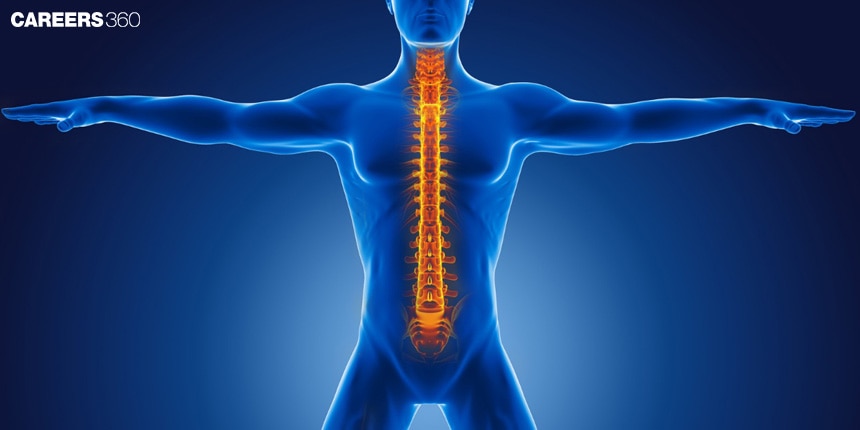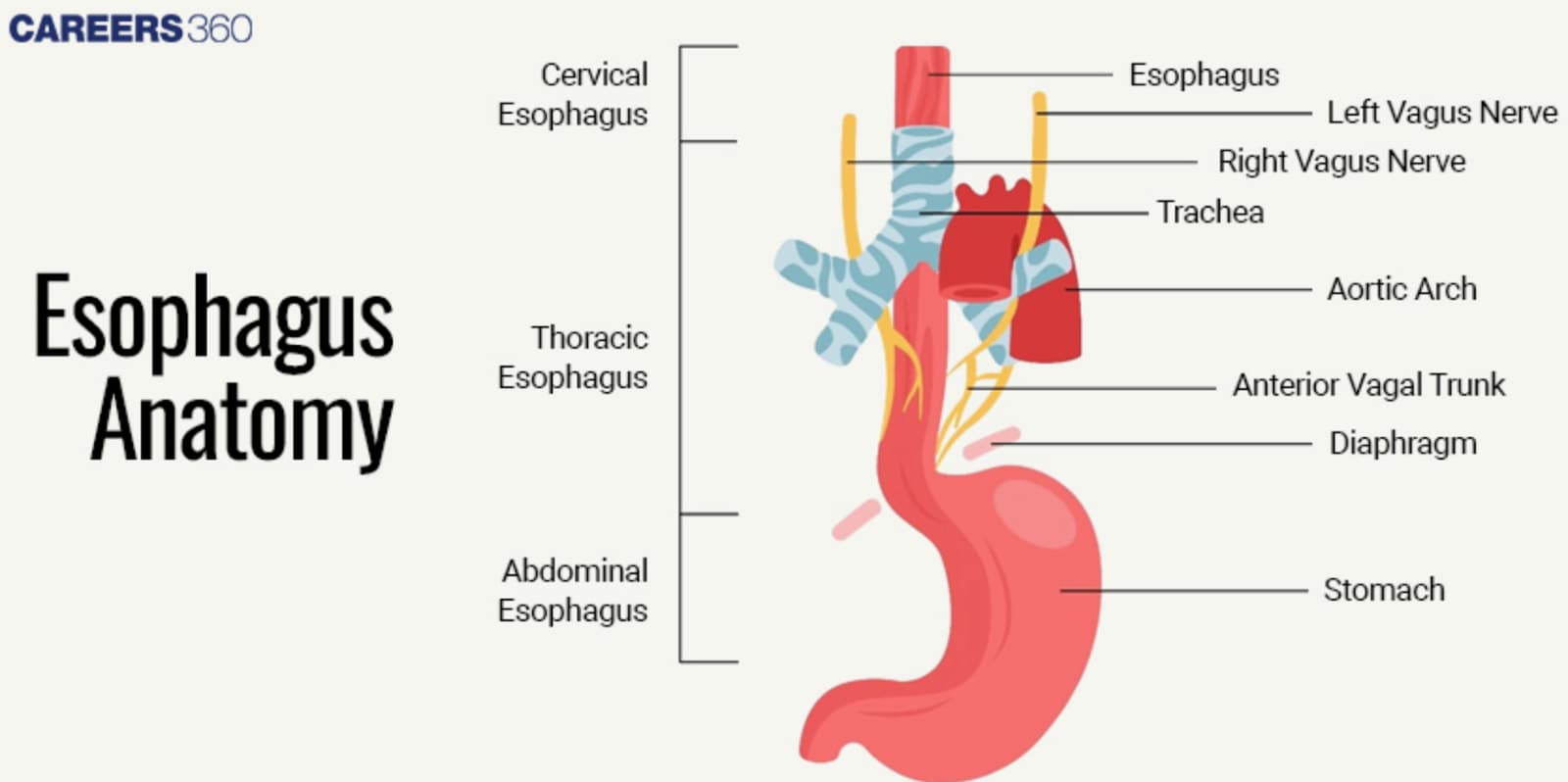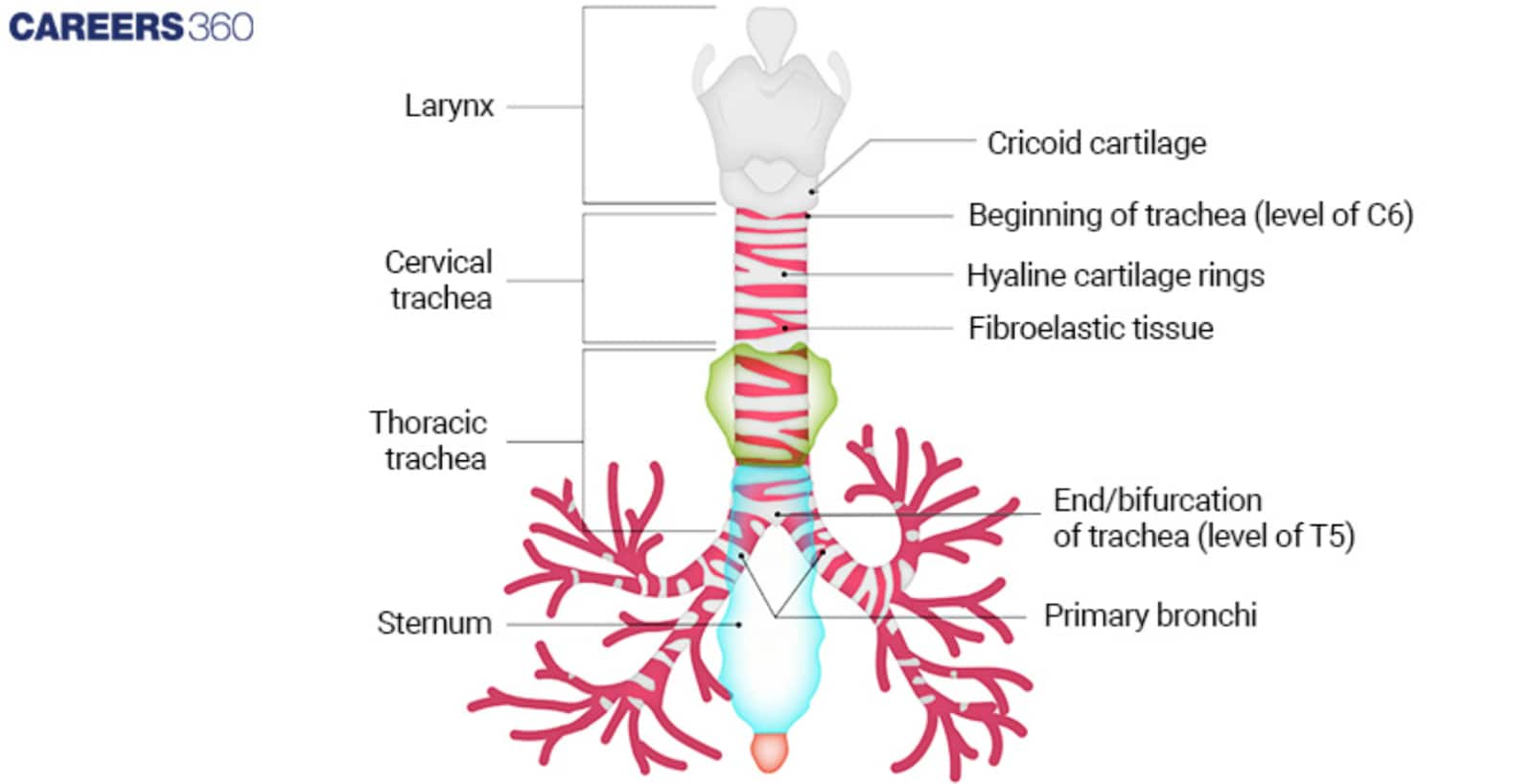Difference Between Esophagus And Trachea: Function & Conditions
The oesophagus and trachea are important tubular structures in the human body with distinct roles. The oesophagus, part of the digestive system, carries food from the throat to the stomach. The trachea, or windpipe, is part of the respiratory system, transporting air to and from the lungs. In this article, the oesophagus and trachea, anatomy of the oesophagus, the function of the esophagus, anatomy of the trachea, the function of the trachea, and physiological functions are discussed. The difference between oesophagus and the trachea is a topic of the chapter Digestion and Absorption in Biology.
This Story also Contains
- What are the Oesophagus and Trachea?
- Anatomy of the Oesophagus
- Function of the Oesophagus
- Anatomy of the Trachea
- Function of the Trachea
- Physiological Functions
- Recommended video for the Difference Between Esophagus and Trachea

What are the Oesophagus and Trachea?
The oesophagus and trachea are both tubes in the human body and have various roles to play in the human system; the respiratory system and the gastrointestinal system. The oesophagus is a muscular canal, which carries food and liquids from the mouth through the pharynx to the stomach while the trachea or windpipe is a tube that also helps to transport air to and from the lungs. This goes a long way in recognising the relation between biological science since the two structures aid in establishing the elementary framework of intricate mechanisms and diseases.
Anatomy of the Oesophagus
Oesophagus is a muscular tube that leads straight from the pharynx, or the throat, to the stomach; and all forms of food and beverages have to go through it. In terms of location relative to other parts of the anatomy, it is located dorsally to the trachea but ventral to the spine and extends from the lower end of the pharynx to the upper section of the stomach.
Structure and layers of the Oesophagus
The oesophagus can be divided into four layers:
Three layers are inherent to the muscle while the fourth and the outermost layer are derived from the skin.
Mucosa: The first layer for protection also has stratified squamous epithelium because the whole layer has to guard the rest of it from such particulate matter as food grains. The submucosa layer includes lamina propria along with muscularis mucosae.
Submucosa: This layer is made of connective, vascular tissue, nerve bundle, and secretion of mucus by glands situated in this layer to facilitate and moisten the oesophagus to enhance passage for foods.
Muscularis: Responsible for controlling and moving the food to the stomach, the muscular layers are interlocked with an inner circular muscle and an outer longitudinal muscle layer. The superior one-third contains only skeletal muscles; the middle one-third contains both skeletal and smooth muscles; and the remaining one-third receives only smooth muscles.
Adventitia: A submucous layer of connective tissue that anchors the oesophagus to neighbouring structures, located just below the epithelium.
Function of the Oesophagus
It has the simple role of conveying solids and liquids taken in through the mouth towards the stomach. This is done by rhythmic contractions of muscles popularly referred to as peristalsis that propels the ingested materials down in a to-and-fro wave-like manner. The oesophagus also has a muscular ringtone called the upper oesophagal sphincter (UES) and lower oesophagal sphincter (LES) that control the opening and closing of the oesophagus to avoid regurgitation of food.

Also Read-
Anatomy of the Trachea
The trachea is also known as the windpipe is another essential organ in the respiratory system. It is a part of the respiratory system that is a tube stretching from the larynx to the bronchi, from which it branches into the right and left bronchi. The trachea is situated in front of the oesophagus and lies medial to it being located in the notch formed by the two cartilages in the neck and upper chest.
Structure and Layers
The trachea consists of several layers, each contributing to its function and structure:
Mucosa: The Labyrinthum has Pseudostratifium columnar epithelium. As for the mucus, it works to capture dust as well as other particles; the cilia, on the other hand, propel the mucus with the dust to the pharynx where it can be swallowed or coughed out.
Submucosa: This layer comprises connective tissues the blood vessels, nerves and the seromucous glands that provide more mucus required for lubricating the trachea and for entrapment of the foreign particles.
Hyaline Cartilage: The trachea is connected from anterior to posterior by 16-20 semicircular rings of hyaline cartilage which offer the trachea rigidity and ensure that there is no blockage of the airway. The flattened part of these C-shaped rings is built to face the oesophagus with the trachea which can expand slightly during swallowing.
Adventitia: The last course of connective tissue that gives additional support and binds the trachea to the other connective tissues.
Function of the Trachea
The trachea consists of several layers, each contributing to its function and structure:
The windpipe is also known as the trachea, and its major role is thus to act as a conduit through which air can pass from the larynx to the bronchi and then to the lungs. In addition, the trachea has certain functions as a barring element, humidifying, and warming the air before getting into the lungs. By this, the cilia and the mucus in the lining of the bronchi and the alveoli filter off dust, bacteria and other particles which could harm the lung.

Comparing the features of the Oesophagus and Trachea
It is one of the important difference and comparison articles in Biology. The important features are listed below-
Feature | Oesophagus | Trachea |
Location in the Body | Posterior to the trachea, extending from the pharynx to the stomach | Anterior to the oesophagus, extending from the larynx to the bronchi |
Tissue Composition | Mucosa: Stratified squamous epithelium Submucosa: Connective tissue, blood vessels, nerves, glands Muscularis: Inner circular and outer longitudinal muscles Adventitia: Connective tissue | Mucosa: Ciliated pseudostratified columnar epithelium with goblet cells Submucosa: Connective tissue, blood vessels, nerves, seromucous glands Hyaline cartilage: C-shaped rings Adventitia: Connective tissue |
Presence of Cartilage | Absent | Present (C-shaped hyaline cartilage rings) |
Length and Diameter | Approximately 25 cm in length; about 2 cm in diameter | Approximately 10-12 cm in length; about 2.5 cm in diameter |
Physiological Functions
The physiological functions are listed below-
Oesophagus
Role in Digestion: The oesophagus has a dual function of acting as a passageway for chewed food and liquids taken into the mouth in the digestion process which has been explained in detail above. This movement is achieved by peristalsis; which is the rhythmic constriction and relaxation of muscles in the gut.
Peristalsis: Thus, the primary mode of transportation of foods in the oesophagus is through peristaltic movements. These rhythmic contractions propel the food along the oesophagus and act as a barrier so that the food does not re-enter the stomach. The recognition of the muscular layer is very important in the process of expulsion of food to the stomach through the coordinated contraction of muscles.
Trachea
Role in Respiration: Respiration is critical because it enables the trachea to deliver air from the larynx to the bronchi and the lungs of individuals. It ensures a constant supply of air as people inhale and exhale.
Airway Protection: To help breathe the trachea has C-shape rings of hyaline cartilage that support it and do not collapse easily. The epithelial lining of the smaller airways causes the trapping of dust and pathogens and by use of cilia to propel mucus upwards to help in the clearance of the airway.
Comparing Physiological Functions of the Oesophagus and Trachea
It is one of the important difference and comparison articles in Biology. The important functions are listed below-
Function | Oesophagus | Trachea |
Primary Role | Transports food and liquids from the mouth to the stomach | Conducts air from the larynx to the bronchi and lungs |
Peristalsis/Airflow | Peristalsis: Coordinated muscular contractions to move food | Airflow: Continuous airflow for respiration, supported by cartilage |
Airway Protection | Prevents food and liquid from entering the airway | Hyaline cartilage rings prevent airway collapse; mucus traps particles |
Mucosal Function | Mucosa: Protects against abrasion from food | Mucosa: Traps dust and pathogens; cilia move mucus upwards |
Also Read-
Recommended video for the Difference Between Esophagus and Trachea
Frequently Asked Questions (FAQs)
The oesophagus's primary purpose is to channel materials that have been taken through the mouth down to the stomach. In this fashion, several coordinated muscular contractions, called peristalsis, propel the taken materials downwards.
The trachea of the respiratory system is mainly to allow free movement of air from the larynx to the bronchi to the lungs. It also filters, humidifies and warms the air breathed in before it gets to the lungs. closure of the trachea and protection of the airway from the particles Since they are C-shaped, these rings do not allow the collapse of the trachea.
In a diagram, the oesophagus and trachea can be differentiated by their structures and surrounding features:
Esophagus: Looks more like a cylindrical tube that has smooth muscles and no cartilage; lies behind the trachea. It normally has a more flexible and collapsible structure, usually about the support mechanism of the building or construction.
Trachea: Out looks like a cylindrical tube that has C-shaped hyaline rings to support its patency or open windpipe. It is situated in front of the esophagus and its mucosal lining as well as its accompanying cartilaginous ring is more well-developed and substantial.
Common diseases affecting the oesophagus include:
Gastroesophageal Reflux Disease (GERD): A condition by which the stomach acid sometimes flows backwards into the oesophagus and brings along with it a burning sensation.
Esophagitis: Irritation of the oesophagus due to some infections, allergies, or substances ingested by the body.
Esophageal Cancer: Cancer that develops in this part of the digestive system thereby interfering with the normal functioning of the esophagus.
Achalasia: A pathology/ disease resulting from the inability of the lower esophageal sphincter to open allowing passage of food into the stomach.
Diagnostic procedures for the trachea include:
Bronchoscopy: An examination in which a physician employs a bronchoscope to examine the trachea and bronchi with a closer look at them. One way it assists in the diagnosis includes Obstructions, infections or any abnormality that may also be detected.
Chest X-ray: A technique of taking pictures that can help identify problems with the trachea, including, but not limited to, stricture, expansion, collapse, or any object lodging in it.
CT Scan (Computed Tomography): Enables cross-sectional images of the trachea to be viewed leading to the diagnosis of conditions like tracheal stenosis or tumour.
Pulmonary Function Tests: analyse the workings of the respiratory system, specifically the capability of air to pass through the trachea and bronchi.